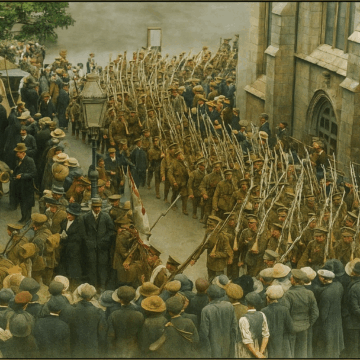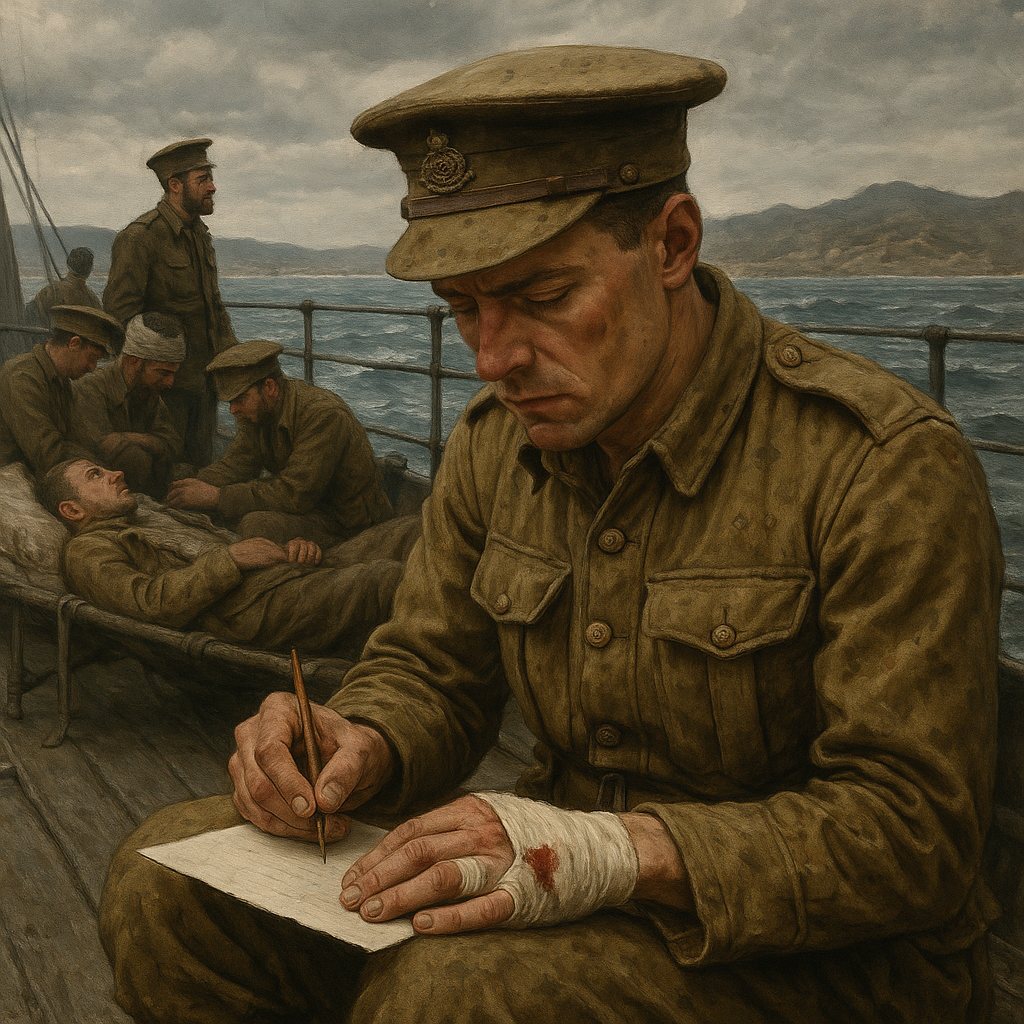He Died of Wounds But Has No Grave: The Astonishing Story of One WWI Soldier
Introduction: Beyond the Numbers
The First World War is often understood through its staggering statistics—millions dead, entire generations lost, and nations reshaped by the sheer scale of the sacrifice. But within these vast, impersonal numbers lie millions of individual stories, each unique and deeply human. When we look closely at the records, we find that the experiences of those who fought and died often challenge our common perceptions of the war.
The story of Private Cyril Rabey is one such case. He was a 19-year-old whose service record reveals a series of profound paradoxes about allegiance, identity, and the brutal realities of the Western Front. His journey—from a quiet Channel Island to a South African regiment with a Scottish identity, ending in the mystery of a grave that should exist but doesn’t—tells a story far more complex than any casualty statistic. Here are the five most impactful takeaways from his sacrifice.
——————————————————————————–
1. A Complex Allegiance: The Guernsey Man in the South African Scottish
Private Rabey from Guernsey did not serve in a local or standard British unit, but in the 4th Battalion, South African Infantry Regiment—a unit nicknamed the “South African Scottish.”
This choice was highly unusual. Private Rabey hailed from St. Martin’s parish on the Channel Island of Guernsey. Most young men in his position would have enlisted in a local militia or a standard British Army regiment. Instead, he volunteered for the South African Overseas Expeditionary Force (SAOEF), an all-volunteer force created because South Africa’s main army was legally barred from fighting overseas.
His decision to join a Dominion force reveals a complex imperial commitment that transcended local allegiance. More fascinatingly, it placed him in a unit with a distinct Scottish heritage, adding another layer to his identity. Here was a Channel Islander, fighting for the Empire under a South African flag, in a regiment that celebrated Scottish traditions. His service speaks to the global, interwoven nature of the war, where identities were fluid and the call to fight was answered in the most unexpected ways.
——————————————————————————–
2. A Ghost Brigade: Joining the Heroes of Delville Wood
Rabey joined one of the Empire’s most celebrated but hardest-hit units, which operated within the British 9th (Scottish) Division.
His regiment was part of the 1st South African Infantry Brigade, a formation that had already earned a formidable and tragic reputation. The brigade’s defining moment came during the Battle of the Somme at Delville Wood in July 1916. There, they fought with legendary tenacity but suffered an astronomical casualty rate of approximately 74%.
This means that Rabey, 19 years old in 1917, was a replacement soldier integrated into a unit still bearing the psychological weight of those catastrophic losses. He joined a ghost brigade, surrounded by veterans who had survived one of the war’s most hellish encounters. To deepen the fascinating tapestry of identity, by 1917 the South African Brigade was formally part of the British 9th (Scottish) Division. This placed Rabey—the Guernsey man in the South African Scottish—under the command of a British Scottish division, a perfect microcosm of the Empire’s fused military structure. The pressure on him to assimilate and perform at an exceptionally high level would have been immense.
——————————————————————————–
3. Victory’s Bitter Price: Surviving the Charge, Not the Aftermath
Rabey’s fatal wound was not sustained during a grand charge, but in the brutal, defensive grind that came as a direct consequence of a stunning victory.
His final battle was the First Battle of the Scarpe, the opening phase of the wider Battle of Arras. Planned as a major diversion for the French Nivelle Offensive, the attack on April 9, 1917, was a massive success. The South Africans advanced so rapidly that they trampled poorly cut German wire underfoot, overwhelming the defenders. But victory on the Western Front had a brutal physics of its own.
The ground gained on April 9th had to be held, and the German response was swift and furious. The days that followed were defined by ferocious counter-attacks and an extremely heavy, sustained artillery bombardment on the newly captured and exposed positions. During this period, which became known as “Bloody April,” the South African Brigade suffered 145 men killed and 549 wounded or missing. Private Rabey died on April 12th, his fatal wounding a direct result of this violent consolidation. Herein lies a core truth of the war: the price of an advance was often paid not in the taking, but in the desperate struggle to keep it.
——————————————————————————–
4. Died in Care, Lost to the Battlefield: The Paradox of a Missing Grave
He was officially recorded as “Died of Wounds,” yet he has “No Known Grave.”
This is the central, poignant paradox of Private Rabey’s story. The status “Died of Wounds” confirms he was recovered from the field alive and entered the medical evacuation chain, where deaths were typically registered and organized burials followed. The fact that he has no known grave is a troubling contradiction that speaks to the sheer chaos of industrial warfare.
There are two likely reasons for this anomaly:
- He may have died at a forward medical post where the deluge of casualties overwhelmed record-keeping.
- He may have received a temporary burial in a grave that was subsequently obliterated by the relentless German shelling that pounded the area, rendering his remains unidentifiable.
This heartbreaking mystery underscores a terrifying truth of industrial war: the battlefield’s destructive power was so immense it could reach into the very arms of the medics and reclaim its dead, leaving behind only a name on a memorial wall.
——————————————————————————–
5. A Dual Memory: Honored by an Empire, Claimed by an Island
Private Rabey’s memory is preserved in two vastly different ways: as one of 34,750 on an imperial scale and as a singular, cherished son on a local level.
His sacrifice is honored in two distinct locations, representing the tension between the war’s immense scope and its intimate cost.
- The Imperial: His name is inscribed on Bay 10 of the Arras Memorial in France. Here, he is an alphabetical entry among 34,750 other missing Imperial servicemen. It is a commemoration of breathtaking scale, acknowledging his role as a soldier of the British Empire, anonymous in a sea of names.
- The Local: His name is also engraved on the St. Martin’s Parish Memorial and the Island (Bailiwick) Memorial in St Peter Port, Guernsey. Here, he is not a number. He is Cyril Rabey of La Bellieuse, a son of the community.
This dual legacy is powerful. Despite his service in a South African unit, his community in Guernsey claimed his memory first and foremost as one of their own. It demonstrates that while empires wage wars, it is the small parishes and towns that bear the individual, enduring weight of each single loss.
——————————————————————————–
Conclusion: A Single Story, A Universal Sacrifice
The story of Private Cyril Rabey—a young man on a complex journey from a small island to a Dominion army and finally to the brutal fields of Arras—reveals the deeply personal and often surprising realities hidden within the historical record. His service challenges simple narratives and reminds us that behind every statistic is a human being with a unique history.
His sacrifice forces us to look closer, to see the individual within the multitude. How many other stories of complex allegiance, quiet courage, and tragic paradox remain unheard within the silent ranks of the millions who served? It is our duty, now, to listen for them.
Discover more from Guernsey Deep Dive
Subscribe to get the latest posts sent to your email.





